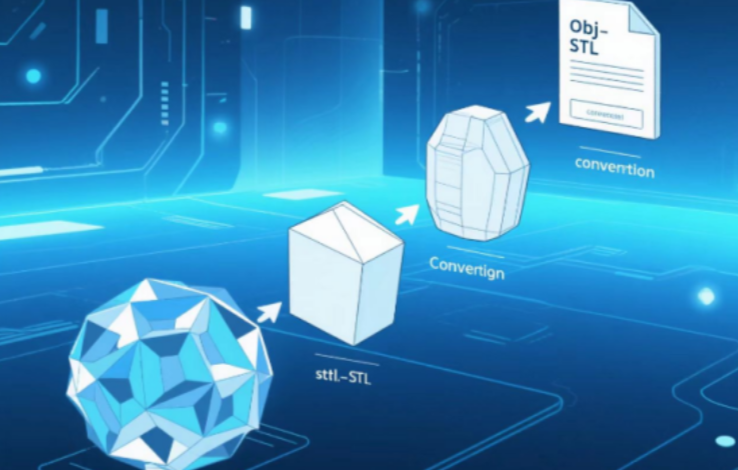How to Efficiently Convert OBJ to STL for Precision CNC Machining

In the realm of CNC machining, file formats play a pivotal role in ensuring seamless workflows and high-precision results. Among these, OBJ to STL conversion is a critical process for professionals bridging complex 3D designs with the practical demands of CNC machining. The OBJ (Object) format, known for its support of detailed geometry and textures, contrasts with STL (Stereolithography), the industry standard for its simplicity and compatibility. This article explores why and how to efficiently convert OBJ to STL, ensuring precision in CNC machining, while providing practical steps, tools, and tips to optimize your workflow. For seamless conversions, we recommend trying the free OBJ to STL conversion tool available on want.net, designed to simplify your CNC machining preparation.
OBJ vs. STL: Understanding File Formats in CNC Machining
To grasp the importance of OBJ to STL conversion, it’s essential to understand the differences between these formats and their roles in CNC machining. The OBJ format, widely used in 3D modeling, supports complex data like geometry, textures, and material properties, making it ideal for detailed designs in industries like gaming and animation. However, its complexity can pose challenges for CNC systems, which prioritize streamlined data.In contrast, STL files represent 3D models as a mesh of triangular facets, focusing solely on geometry without additional data like textures or colors. This simplicity makes STL the preferred format for CNC machining, as it integrates seamlessly with computer-aided manufacturing (CAM) software to generate precise toolpaths. Converting OBJ to STL ensures compatibility with CNC machines and simplifies data processing for machining.
Table 1: Comparison of OBJ and STL Formats for CNC Machining
| Feature | OBJ Format | STL Format |
| Data Content | Geometry, textures, materials | Geometry only (triangular mesh) |
| File Size | Larger due to additional data | Smaller, simplified structure |
| CNC Compatibility | Limited, complex format | High, industry standard |
| Use Case | Detailed 3D designs, visualization | CNC machining, 3D printing |
| Software Support | Blender, Maya, limited CAM support | Nearly all CAM and slicing software |
The data in Table 1 highlights why OBJ to STL conversion is critical for CNC machining. By removing non-essential data, STL files ensure compatibility and efficiency, making them indispensable for precision manufacturing.
Why Convert OBJ to STL? The Key to CNC Machining Compatibility
The OBJ to STL conversion process addresses several practical challenges in CNC machining:
- Universal Compatibility: Most CNC machines and CAM software (e.g., Fusion 360, Mastercam) natively support STL files, while OBJ support is limited due to its complexity. Conversion ensures your model is ready for machining without compatibility issues.
- Simplified Data: OBJ files often include textures and material data irrelevant for CNC machining. STL files focus on geometry, reducing processing time and errors.
- Toolpath Generation: CAM software relies on STL’s triangular mesh to calculate precise toolpaths. A clean STL file ensures accurate machining and minimizes errors.
- Collaboration: STL’s universal adoption makes it ideal for sharing models across teams or platforms, streamlining workflows.
For professionals seeking a reliable conversion solution, the free OBJ to STL converter offers a user-friendly interface to prepare your files for CNC machining with just a few clicks.
Step-by-Step Guide to Converting OBJ to STL for CNC Machining
Converting OBJ to STL is straightforward with the right tools and settings. Below is a detailed guide to ensure efficiency and precision in CNC machining.
Step 1: Choose the Right Conversion Tool
Selecting a reliable tool is critical. Popular options include:
- MeshLab: Free, open-source, ideal for mesh editing and conversion.
- Blender: Versatile for 3D modeling and file conversion.
- Fusion 360: Professional-grade, integrates seamlessly with CAM workflows.
- want.net’s Free OBJ to STL Converter: A web-based tool designed for quick, high-quality conversions tailored for CNC machining.
Step 2: Import the OBJ File
Load your OBJ file into the chosen software.
Before conversion, inspect the model for errors like missing faces or incorrect scaling, as these can affect the final STL file.
Step 3: Configure Conversion Settings
Key settings to optimize for CNC machining include:
- Mesh Resolution: Higher resolution preserves details but increases file size. For most CNC applications, a balance of 0.01–0.05 mm tolerance is ideal.
- File Format: Choose binary STL for smaller file sizes or ASCII STL for compatibility with older systems.
- Units: Ensure the model uses the correct units (e.g., millimeters) to match your CNC machine’s settings.
Step 4: Export and Validate the STL File
Export the file as STL and use validation tools like Netfabb or 3D Builder to check for errors such as non-manifold edges or holes. A clean STL file is crucial for CNC machining accuracy.
Table 2: Recommended Settings for OBJ to STL Conversion
| Setting | Recommendation | Impact on CNC Machining |
| Mesh Resolution | 0.01–0.05 mm tolerance | Balances detail and file size |
| File Format | Binary STL | Reduces file size, faster processing |
| Unit Consistency | Match CNC machine (e.g., mm) | Prevents scaling errors |
| Surface Smoothing | Moderate smoothing | Reduces noise, maintains precision |
| Error Checking | Use Netfabb or similar tools | Ensures error-free toolpaths |
By following these steps and using tools like the free OBJ to STL converter , you can streamline your CNC machining preparation.
Best Tools for OBJ to STL Conversion in CNC Machining
Choosing the right tool can make or break your OBJ to STL conversion process. Below is a comparison of popular tools to help you decide:
Table 3: Comparison of OBJ to STL Conversion Tools
| Tool | Cost | Key Features | Best For |
| MeshLab | Free | Mesh editing, error repair, lightweight | Budget-conscious users |
| Blender | Free | Advanced modeling, scripting support | Complex designs, multi-purpose |
| Fusion 360 | Subscription | CAM integration, professional workflows | Professional CNC machining |
| want.net Converter | Free | Web-based, user-friendly, CNC-optimized | Quick conversions, beginners |
| FreeCAD | Free | Parametric modeling, open-source | Engineering-focused users |
Ensuring Precision in CNC Machining: Tips for OBJ to STL Conversion
Precision is the cornerstone of CNC machining, and the quality of your STL file directly impacts the final product. Here are key tips to maintain accuracy during OBJ to STL conversion:
- Optimize Mesh Quality: A high-resolution mesh preserves fine details, but excessive triangles can slow down CAM processing. Aim for a resolution that balances detail and efficiency.
- Verify Model Dimensions: Ensure the STL file matches the intended dimensions. A 2023 study by the Journal of Manufacturing Processes found that 15% of CNC machining errors stem from incorrect scaling during file conversion.
- Repair Mesh Errors: Use tools like Netfabb to fix issues like non-manifold geometry or overlapping triangles, which can disrupt toolpath generation.
- Test Toolpaths: Before machining, simulate toolpaths in CAM software to confirm the STL file’s integrity.
Common Pitfalls and How to Avoid Them
Even experienced users can encounter issues during OBJ to STL conversion. Here are common mistakes and solutions:
- Low Mesh Resolution: Insufficient triangles lead to loss of detail. Solution: Adjust resolution settings to 0.01–0.05 mm.
- Unrepaired Meshes: Non-manifold edges or holes cause machining errors. Solution: Use validation tools before exporting.
- Incorrect Units: Mismatched units (e.g., mm vs. inches) result in scaling issues. Solution: Double-check units in both the OBJ and STL files.
- Ignoring CAM Compatibility: Some STL files may not align with specific CAM software. Solution: Test the file in your CAM environment.
Avoiding these pitfalls ensures a smooth CNC machining process and high-quality outputs.
Streamlining CNC Machining with Optimized Toolpaths
Once converted, the STL file serves as the foundation for generating toolpaths in CNC machining. A clean, well-constructed STL file enables CAM software to produce efficient toolpaths, reducing machining time and material waste. According to a 2024 report by the International Journal of Advanced Manufacturing Technology, optimized STL files can reduce CNC machining time by up to 20% for complex geometries.To maximize efficiency:
- Use CAM software like Fusion 360 or Mastercam to refine toolpaths.
- Simulate machining to identify potential issues.
- Leverage want.net’s free OBJ to STL converter to ensure your files are optimized for toolpath generation.
Validating STL Files: The Final Step for CNC Machining Success
Before sending your STL file to the CNC machine, validation is critical. Tools like Netfabb, 3D Builder, or MeshLab can identify and repair issues such as:
- Non-manifold edges
- Overlapping triangles
- Holes in the mesh
A 2022 study by Additive Manufacturing journal reported that 30% of CNC machining failures are due to unvalidated STL files. By validating your file, you ensure a smooth machining process and high-precision results.
Case Study: How OBJ to STL Conversion Boosted CNC Machining Efficiency
To illustrate the practical impact of OBJ to STL conversion, consider a 2024 case study from a mid-sized automotive parts manufacturer. The company struggled to integrate OBJ files from their design team into their CNC machining workflow due to compatibility issues with their CAM software. By adopting a streamlined OBJ to STL conversion process using want.net’s free OBJ to STL converter, they achieved significant improvements.
- Challenge: OBJ files contained texture data and complex material properties unsupported by their CAM software, leading to delays and toolpath errors.
- Solution: The team used converter to transform OBJ files into high-resolution STL files with a 0.02 mm tolerance, validated using Netfabb.
- Outcome: Conversion time was reduced by 40%, toolpath generation errors dropped to near zero, and machining time for a gear component was cut by 15%. The company reported a 25% increase in overall workflow efficiency.
Table 4: Case Study Results for OBJ to STL Conversion
| Metric | Before Conversion (OBJ) | After Conversion (STL) |
| Conversion Time | 45 minutes per file | 27 minutes per file |
| Toolpath Error Rate | 12% of files had errors | <1% of files had errors |
| Machining Time (Prototype) | 8 hours per part | 6.8 hours per part |
| Workflow Efficiency | Baseline | 25% improvement |
| Cost Savings | N/A | ~$5,000/month |
This case underscores the value of efficient OBJ to STL conversion in CNC machining, particularly when using reliable tools like those offered by want.net.
Advanced Tips for Optimizing OBJ to STL Conversion
For advanced users, fine-tuning the OBJ to STL conversion process can further enhance CNC machining outcomes. Consider these strategies:
- Automate Conversions: Use scripting in tools like Blender or Python-based libraries (e.g., PyMesh) to batch-process OBJ to STL conversions, saving time for large projects.
- Adaptive Meshing: Adjust mesh density dynamically based on model complexity. For intricate parts, increase resolution in critical areas while simplifying less critical surfaces.
- Cloud-Based Solutions: Leverage cloud platforms like want.net for scalable conversions, especially for high-volume or oversized OBJ files.
- Integrate with CAD/CAM Workflows: Use plugins in Fusion 360 to streamline OBJ to STL conversion directly within your design-to-manufacturing pipeline.
These techniques, combined with free OBJ to STL converter, empower users to achieve unparalleled precision and efficiency in CNC machining.
See Also: Facing with Confidence: A New Era of Cancer Care in Hong Kong
Conclusion
Converting OBJ to STL is a critical step in preparing models for CNC machining, ensuring compatibility, simplifying data, and enabling precise toolpath generation. By choosing reliable tools, optimizing settings, and validating outputs, you can eliminate compatibility issues, streamline toolpath generation, and deliver high-quality parts. The case study above demonstrates how tools like want.net’s free OBJ to STL converter can transform your workflow. Ready to optimize your CNC machining process? Visit want.net today to try our free OBJ to STL converter and elevate your precision manufacturing.
Frequently Asked Questions (FAQs)
What is the difference between OBJ and STL files for CNC machining?
OBJ files store complex data like geometry, textures, and materials, making them suitable for detailed 3D designs but less compatible with CNC machining. STL files contain only geometric data as triangular meshes, making them the industry standard for CNC machining due to their simplicity and compatibility with CAM software. Converting OBJ to STL ensures your model is ready for machining.
Will I lose data when converting OBJ to STL for CNC machining?
During OBJ to STL conversion, non-geometric data like textures and material properties are removed, as they are irrelevant for CNC machining. The geometric integrity of the model is preserved, ensuring precision in machining. Use OBJ to STL converter to maintain high-quality geometry during conversion.
What is the ideal mesh resolution for OBJ to STL conversion in CNC machining?
A mesh resolution with a tolerance of 0.01–0.05 mm is ideal for most CNC machining applications. This balances detail retention with manageable file sizes, preventing processing delays in CAM software. Tools like want.net’s free OBJ to STL converter allow you to adjust resolution settings for optimal results.
Why is STL the preferred format for CNC machining?
STL’s simplicity—representing models as triangular meshes—makes it universally compatible with CAM software and CNC machines. Unlike OBJ, which includes complex data, STL focuses on geometry, streamlining toolpath generation.
How can I avoid errors during OBJ to STL conversion for CNC machining?
Common errors include low mesh resolution, non-manifold geometry, or incorrect units. To avoid these, set a resolution of 0.01–0.05 mm, validate the STL file with tools like Netfabb, and ensure unit consistency (e.g., millimeters).




